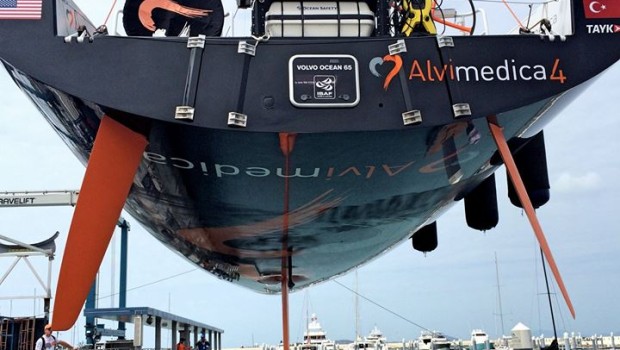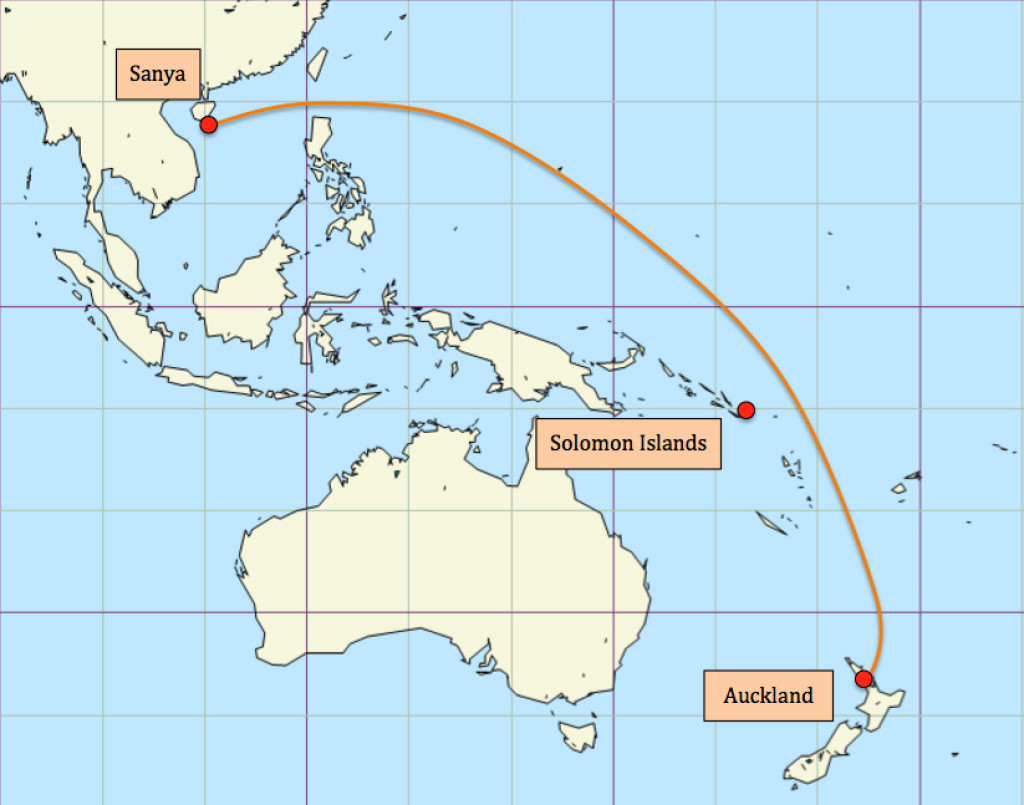Volvo Ocean Race faces potential boat-breaking conditions
Published on February 6th, 2015
Everyone knows that the shortest point between A and B is a straight line. Trouble is, in sailing it’s not always the quickest. Never could this be more true than on Leg 4 of the Volvo Ocean Race, according to Team Alvimedica’s navigation support and performance analyst, Anderson Reggio.
“When you get into the Pacific Ocean, it may actually pay to be sailing hard east, maybe even slightly north of that, and more towards Japan than Auckland,” Reggio says.
Such are the dilemmas that Reggio has been poring over in great detail alongside Team Alvimedica’s on-board navigator, Will Oxley. The challenges begin right out of the start from Sanya.
“The geography between Taiwan, China and the South China Sea means that the north-east monsoon breezes have a tendency to accelerate between the land masses,” says Reggio. “Also, the currents that come up from the Philippines tend to mix and create an awful sea state through the Strait of Luzon, the stretch of water between Taiwan and the northern tip of the Philippines. That’s what we’re looking at for the start of Leg 4, potential boat-breaking conditions.”
After three fairly soft legs in the race, the start of Leg 4 could be a rude awakening, with up to 30 knots of wind and a nasty sea state. It will require the crews possibly to throttle back and sail in boat-preservation mode rather than push for all-out speed. But presuming the fleet makes it safely out of the South China Sea and into the Pacific, the next problem is which way to go. “It’s the constant play in sailing of, is it worth taking a short-term loss for the long-term gain?” says Reggio.
“Sailing north literally takes you in the opposite direction of where you want to go, but in the last race Puma went so far north because they thought in the long term it was going to give them significantly better pressure, and they were going to get to that pressure before anybody else. With the Doldrums down around the Solomon Islands, they were hopeful it was going to put them very far east in that set-up. And the further east you are, the narrower the Doldrums tend to be.”
So, speculate to accumulate, but it’s still a brave navigator who opts for that northerly route, however well it might have worked out last time three years ago. With the boats now one-design, and the fleet far more tightly bunched in this edition than previous Volvo Ocean Races, the dilemma becomes even harder to justify, according to Reggio. “You have 3,000 miles to get from Taiwan to the Solomon Islands, which is where you can expect to meet the unpredictability of the Doldrums. Last time round, that move north only started to pay dividends five or six days later. In this game now, with all the boats identical, it’s harder to convince yourself to get away from the pack.”
Reggio’s analysis points to 75% of this 5,264 nautical mile leg taking place on port tack, with the wind mostly on the beam.
If the fleet does decide to abandon the ‘Great Northern Route’ in favor of something more straightforward and direct, straight-line boatspeed will be critical. However, there are still tactical and strategic choices to be made, says Reggio.
“When you come out into the Pacific, you’re into a generally north to north-easterly flow of trade winds. The further south you go, typically the further right the breeze goes. So if you go south first, you sail a lot less distance down the rhumb line, but you get headed as you go on port tack, possibly necessitating you to tack out of there. That would be a bad angle, when everybody else is sailing down over the top of you. So it’s often better to stay high early and come down south later. Plus, the further east you can get, the thinner the Doldrums. So it’s going to be a similar play to what you saw with the Equator crossing in Leg 1 to Cape Town, but just flip it the other way. Leg 1: the further west you got, the thinner the Doldrums; Leg 4: the further east you go, the thinner the Doldrums.”
In the earlier editions of the race – formerly known as the Whitbread Race – the fleet crossed the dreaded randomness of the Equatorial winds just twice, one down the Atlantic and once back up. But in the modern race, this Pacific crossing of the Equator will be the fleet’s third time through the Intertropical Convergence Zone (ITCZ), with a fourth still to come on Leg 6 from Itajai, Brazil, to Newport, Rhode Island. After 3,000 miles of sailing from Sanya, the fleet could well be facing a restart of Leg 4 at the Equator.
The fleet sets out from Sanya, China on Sunday February 8 on Leg Four of the Volvo Ocean Race to Auckland, New Zealand. Team Alvimedica is expected to arrive in New Zealand approximately March 1 – March 3.
Team Alvimedica is the youngest entry in the Volvo Ocean Race 2014-2015, the world’s toughest and longest sporting event. The crew is led by American skipper Charlie Enright, age 30. Alvimedica, the European based medical devices company, is the team’s owner. Founded in 2007, Alvimedica is a fast growing challenger in the global field of interventional cardiology, committed to developing minimally-invasive technologies. This is the team’s first entry in the extremely challenging 39,000-mile race that started October 11, 2014 from Alicante, Spain and features stopovers in 11 ports around the world.
Report by Team Alvimedica
Team Alvimedica – Race website – Tracking – Scoreboard – Videos
Background: The 2014-15 Volvo Ocean Race began in Alicante, Spain on Oct. 11 with the final finish on June 27 in Gothenburg, Sweden. Racing the new one design Volvo Ocean 65, seven teams will be scoring points in 9 offshore legs to determine the overall Volvo Ocean Race winner. Additionally, the teams will compete in 10 In-Port races at each stopover for a separate competition – the Volvo Ocean Race In-Port Series.










 We’ll keep your information safe.
We’ll keep your information safe.